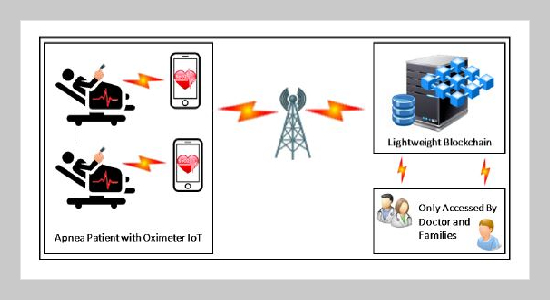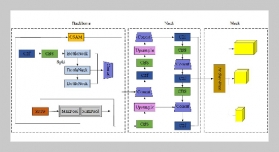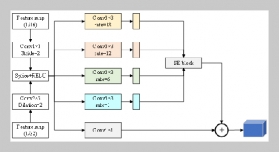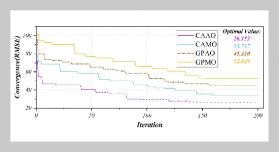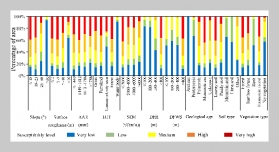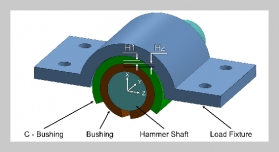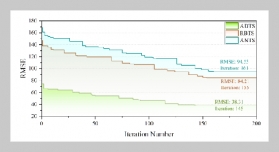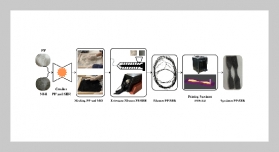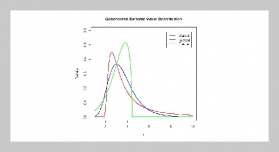REFERENCES
- [1] M. Mettler. “Blockchain technology in healthcare: The revolution starts here”. In: 2016 IEEE 18th International Conference on e-Health Networking, Applications and Services (Healthcom), 1–3. DOI: https://doi.org/10.1109/HealthCom.2016.7749510.
- [2] G. Hasenstab. Three Ways Blockchain Is Improving Our Lives Now. 2019. URL: https://www.forbes.com/sites/forbesrealestatecouncil/2019/12/02/threeways-blockchain - is - improving- our- lives - now/?sh=201ba3894572.
- [3] A. Sharma, Sarishma, R. Tomar, N. Chilamkurti, and B.-G. Kim, (2020) “Blockchain Based Smart Contracts for Internet of Medical Things in e-Healthcare" Electronics 9(10): DOI: https : //doi.org/10.3390/electronics9101609.
- [4] A. Ekblaw, A. Azaria, J. D. Halamka, and A. Lippman. A Case Study for Blockchain in Healthcare:“MedRec” prototype for electronic health records and medical research data — MIT Media Lab. 2016. URL: https: //www.media.mit.edu/publications/medrec-whitepaper/.
- [5] A. Azaria, A. Ekblaw, T. Vieira, and A. Lippman. “MedRec: Using Blockchain for Medical Data Access and Permission Management”. In: 2016 2nd International Conference on Open and Big Data (OBD), 25–30. DOI: https://doi.org/10.1109/OBD.2016.11.
- [6] J. Zhang and M. Wu, (2020) “Blockchain Use in IoT for Privacy-Preserving Anti-Pandemic Home Quarantine" Electronics 9(10): DOI: https://doi.org/10.3390/electronics9101746.
- [7] A. Dorri, S. S. Kanhere, R. Jurdak, and P. Gauravaram. “Blockchain for IoT security and privacy: The case study of a smart home”. In: 2017 IEEE International Conference on Pervasive Computing and Communications Workshops (PerCom Workshops), 618–623. DOI: https: //doi.org/10.1109/PERCOMW.2017.7917634.
- [8] Y. Zhang and J.Wen, (2017) “The IoT electric business model: Using blockchain technology for the internet of things" Peer-To-Peer Networking and Applications 10(4): 983–994. DOI: http://dx.doi.org/10.1007/s12083-016-0456-1.
- [9] H. Tan, P. Kim, and I. Chung, (2020) “Practical Homomorphic Authentication in Cloud-Assisted VANETs with Blockchain-Based Healthcare Monitoring for Pandemic Control" Electronics 9(10): DOI: https://doi.org/10.3390/electronics9101683.
- [10] V. Astarita, V. P. Giofrè, G. Mirabelli, and V. Solina, (2020) “A Review of Blockchain-Based Systems in Transportation" Information 11(1): DOI: https://doi.org/10.3390/info11010021.
- [11] V. Elagin, A. Spirkina, M. Buinevich, and A. Vladyko, (2020) “Technological Aspects of Blockchain Application for Vehicle-to-Network" Information 11(10): DOI: https: //doi.org/10.3390/info11100465.
- [12] S. Huckle, R. Bhattacharya, M. White, and N. Beloff, (2016) “Internet of Things, Blockchain and Shared Economy Applications" Procedia Computer Science 98: 461–466. DOI: https://doi.org/10.1016/j.procs.2016.09.074.
- [13] P. Hurich, (2016) “The Virtual is Real: An Argument for Characterizing Bitcoins as Private Property" Banking & Finance Law Review 31(3): 573–583.
- [14] X. Xu, C. Pautasso, L. Zhu, V. Gramoli, A. Ponomarev, A. B. Tran, and S. Chen. “The Blockchain as a Software Connector”. In: 2016 13th Working IEEE/IFIP Conference on Software Architecture (WICSA), 182–191.DOI: https://doi.org/10.1109/WICSA.2016.21.
- [15] W. Cai, Z. Wang, J. B. Ernst, Z. Hong, C. Feng, and V. C. M. Leung, (2018) “Decentralized Applications: The Blockchain-Empowered Software System" IEEE Access 6: 53019–53033. DOI: https: //doi.org/10.1109/ACCESS.2018.2870644.
- [16] N. Kshetri and J. Voas, (2018) “Blockchain-Enabled EVoting" IEEE Software 35(4): 95–99. DOI: https://doi.org/10.1109/MS.2018.2801546.
- [17] C.-k. Chang, (2020) “Blockchain for Integrated Nuclear Power Plants Management System" Information 11(6): DOI: https://doi.org/10.3390/info11060282.
- [18] S. Nakamoto, (2009) “Bitcoin: A Peer-to-Peer Electronic Cash System":
- [19] S. Tuli, R. Mahmud, S. Tuli, and R. Buyya, (2019) “FogBus: A Blockchain-based Lightweight Framework for Edge and Fog Computing" Journal of Systems and Software 154: 22–36. DOI: https://doi.org/10.1016/j.jss.2019.04.050.
- [20] J. Zhang, N. Xue, and X. Huang, (2016) “A Secure System For Pervasive Social Network-Based Healthcare" IEEE Access 4: 9239–9250. DOI: https://doi.org/10.1109/ACCESS.2016.2645904.
- [21] N. Jia, R.Wang, M. Li, Y. Guan, and F. Zhou, (2021) “Towards the Concurrent Optimization of the Server: A Case Study on Sport Health Simulation" Complexity 2021: 5587170. DOI: https://doi.org/10.1155/2021/5587170.
- [22] T. Bizimungu, D. Harelimana, and J. Marie Ntaganda, “A Client-Server and Web-Based Graphical User Interface Design for the Mathematical Model of Cardiovascular-Respiratory System" Applied Computational Intelligence and Soft Computing 2021: 5581937. DOI: https: //doi.org/10.1155/2021/5581937.
- [23] L. Ibraimi, M. Asim, and M. Petkovi´c. “Secure management of personal health records by applying attribute-based encryption”. In: Proceedings of the 6th International Workshop on Wearable, Micro, and Nano Technologies for Personalized Health, 71–74. DOI: https: //doi.org/10.1109/PHEALTH.2009.5754828.
- [24] M. A. Sarwar, T. Bashir, O. Shahzad, and A. Abbas, (2019) “Cloud-Based Architecture to Implement Electronic Health Record (EHR) System in Pakistan" IT Professional 21(3): 49–54. DOI: https://doi.org/10.1109/MITP.2018.2882437.
- [25] X. Yan and X. Ren, “5G Edge Computing Enabled Directional Data Collection for Medical Community Electronic Health Records" Journal of Healthcare Engineering 2021: 5598077. DOI: https://doi.org/10.1155/2021/5598077.
- [26] D. D. L. F. Simon Fernandez-Vazquez Rafael Rosillo and P. Priore, (2019) “Blockchain in FinTech: A Mapping Study" Sustainability MDPI 11(22): DOI: https: //doi.org/10.3390/su11226366.
- [27] E. A. A. Lukman Adewale Ajao James Agajo and L. Karngong, (2019) “Crypto Hash Algorithm-Based Blockchain Technology for Managing Decentralized Ledger Database in Oil and Gas Industry" Multidisciplinary Scientific Journal - MDPI 2(3): 300–325
- [28] C. Arnold, D. Kiel, and K.-I. Voigt, (2016) “How The Industrial Internet of Things Changes Business Models in Different Manufacturing Industries" International Journal of Innovation Management 20(08): 1640015. DOI: https://doi.org/10.1142/S1363919616400156.
- [29] J. Bonneau, A. Miller, J. Clark, A. Narayanan, J. A. Kroll, and E. W. Felten. “SoK: Research Perspectives and Challenges for Bitcoin and Cryptocurrencies”. In: 2015 IEEE Symposium on Security and Privacy, 104–121. DOI: https://doi.org/10.1109/SP.2015.14.
- [30] L. Cocco and M. Marchesi, (2016) “Modeling and Simulation of the Economics of Mining in the Bitcoin Market" PLOS ONE 11: DOI: https: //doi.org/10.1371/journal.pone.0164603.
- [31] S. Javaheri, F. Barbe, F. Campos-Rodriguez, J. A. Dempsey, R. Khayat, S. Javaheri, A. Malhotra, M. A. Martinez-Garcia, R. Mehra, A. I. Pack, V. Y. Polotsky, S. Redline, and V. K. Somers, (2017) “Sleep Apnea" Journal of the American College of Cardiology 69(7): 841. DOI: https://doi.org/10.1016/j.jacc.2016.11.069.
- [32] W. Su, G. Chen, D. Ma, J. Zeng, F. Yan, X. Lin, Z. Xu, S. Yang, Z. Li, and C. Liu, “Higher Apnea-Hypopnea Index (AHI) and Oxygen Desaturation Index (ODI)Were Independently Associated with Increased Risks of Hypertension in Patients with T2DM: A Cross-Sectional Study" International Journal of Hypertension 2021: 8887944. DOI: https: //doi.org/10.1155/2021/8887944.
- [33] T. Saunamäki, E. Huupponen, J. Loponen, and S.-L. Himanen, (2017) “CPAP Treatment Partly Normalizes Sleep Spindle Features in Obstructive Sleep Apnea" Sleep Disorders 2017: 2962479. DOI: https://doi.org/10.1155/2017/2962479.
- [34] AASM, (2008) “Obstructive Sleep Apnea" 2019(December 13):
- [35] S. Shankar, S. S. Gupta, G. Rojas-Marte, S. Demir, A. Saxena, C. Obiagwu, N. Aggarwal, A. K. Rai, S. Kamholz, V. Shetty, and Y. Kupfer, (2019) “Electrocardiographic Associations Seen with Obstructive Sleep Apnea" Sleep Disorders 2019: 9704785. DOI: https://doi.org/10.1155/2019/9704785.
- [36] A. Manoni, F. Loreti, V. Radicioni, D. Pellegrino, L. Della Torre, A. Gumiero, D. Halicki, P. Palange, and F. Irrera, (2020) “A New Wearable System for Home Sleep Apnea Testing, Screening, and Classification" Sensors 20(24): DOI: https://doi.org/10.3390/s20247014.
- [37] C. Esteban-Amarilla, S. Martin-Bote, A. Jurado-Garcia, A. Palomares-Muriana, N. Feu-Collado, and B. Jurado-Gamez, “Usefulness of Home Overnight Pulse Oximetry in Patients with Suspected Sleep-Disordered Breathing" Canadian Respiratory Journal 2020: 1891285. DOI: https://doi.org/10.1155/2020/1891285.
- [38] S. Shah, K. Majmudar, A. Stein, N. Gupta, S. Suppes, M. Karamanis, J. Capannari, S. Sethi, and C. Patte, (2020) “Novel Use of Home Pulse Oximetry Monitoring in COVID-19 Patients Discharged From the Emergency Department Identifies Need for Hospitalization" Academic Emergency Medicine 27(8): 681–692. DOI: https://doi.org/10.1111/acem.14053.
- [39] A. Von Chong, M. Terosiet, A. Histace, and O. Romain, (2019) “Towards a novel single-LED pulse oximeter based on a multispectral sensor for IoT applications" Microelectronics Journal 88: 128–136. DOI: https: //doi.org/10.1016/j.mejo.2018.03.005.
- [40] MIT and Google. MIT App Inventor | Explore MIT App Inventor. 2010. URL: http://appinventor.mit.edu/.
- [41] B. Xie and H. Abelson. “Skill progression in MIT app inventor”. In: 2016 IEEE Symposium on Visual Languages and Human-Centric Computing (VL/HCC), 213–217. DOI: https://doi.org/10.1109/VLHCC.2016.7739687.
- [42] P. Vimalachandran, H. Wang, Y. Zhang, B. Heyward, and F. Whittaker. “Ensuring Data Integrity in Electronic Health Records: A Quality Health Care Implication”. In: International Conference on Orange Technologies. DOI: https://doi.org/10.1109/ICOT.2016.8278970.
- [43] A. K. Rattan, (2018) “Data Integrity: History, Issues, and Remediation of Issues" PDA J Pharm Sci Technol 72(2): 105–116. DOI: https://doi.org/10.5731/pdajpst.2017.007765.
- [44] WHO, (2014) “Annex 5 Guidance on good data and record management practices":
- [45] X. Liang, J. Zhao, S. Shetty, J. Liu, and D. Li. “Integrating blockchain for data sharing and collaboration in mobile healthcare applications”. In: 2017 IEEE 28th Annual International Symposium on Personal, Indoor, and Mobile Radio Communications (PIMRC), 1–5. DOI: https://doi.org/10.1109/PIMRC.2017.8292361.
- [46] S.-W. Noh, Y. Park, C. Sur, S.-U. Shin, and K.-H. Rhee, (2017) “Blockchain-Based User-Centric Records Management System" International Journal of Control and Automation 10: 133–144. DOI: https://dx.doi.org/10.14257/ijca.2017.10.11.12.
- [47] X. Zheng, R. R. Mukkamala, R. Vatrapu, and J. Ordieres-Mere. “Blockchain-based Personal Health Data Sharing System Using Cloud Storage”. In: 2018 IEEE 20th International Conference on e-Health Networking, Applications and Services (Healthcom), 1–6. DOI: https://doi.org/10.1109/HealthCom.2018.8531125.
- [48] K. Fan, S. Wang, Y. Ren, H. Li, and Y. Yang, (2018) “MedBlock: Efficient and Secure Medical Data Sharing Via Blockchain" Journal of Medical Systems 42(8): 1–11. DOI: https://dx.doi.org/10.1007/s10916-018-0993-7.
- [49] V. Patel, (2018) “A framework for secure and decentralized sharing of medical imaging data via blockchain consensus" Health Informatics Journal 25(4): 1398–1411. DOI: https://doi.org/10.1177/1460458218769699.
- [50] L. Zhu, Y. Wu, K. Gai, and K.-K. R. Choo, (2019) “Controllable and trustworthy blockchain-based cloud data management" Future Generation Computer Systems 91: 527–535. DOI: https://doi.org/10.1016/j.future.2018.09.019.
- [51] L. Ismail, H. Materwala, and S. Zeadally, (2019) “Lightweight Blockchain for Healthcare" IEEE Access 7: 149935–149951. DOI: https://doi.org/10.1109/ACCESS.2019.2947613.
- [52] J. Fu, N. Wang, and Y. Cai, (2020) “Sensor Research; New Sensor Research Study Findings Recently Were Reported by Researchers at Beijing University of Posts and Telecommunications (Privacy-Preserving in Healthcare Blockchain Systems Based on Lightweight Message Sharing)" Health & MedicineWeek: 3596.
- [53] J. Chiu and T. V. Koeppl, (2019) “Blockchain-Based Settlement for Asset Trading" The Review of Financial Studies 32(5): 1716–1753. DOI: https://doi.org/10.1093/rfs/hhy122.
- [54] Y. Aoki, K. Otsuki, T. Kaneko, R. Banno, and K. Shudo. “SimBlock: A Blockchain Network Simulator”. In: IEEE INFOCOM 2019 - IEEE Conference on Computer Communications Workshops (INFOCOM WKSHPS), 325–329. DOI: https ://doi.org/10.1109/INFCOMW.2019.8845253.
- [55] U. W. Chohan, (2017) “A History of Dogecoin": DOI: http://dx.doi.org/10.2139/ssrn.3091219.


